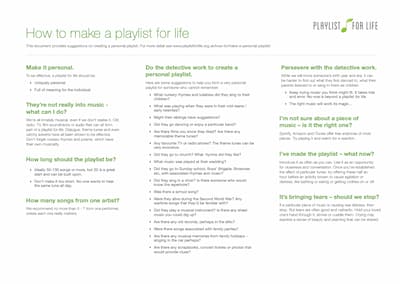How to make a playlist for life
This post provides suggestions on creating a personal playlist. For more details see playlistforlife.org.uk or download the PDF below:

Make it personal
To be effective, a playlist for life should be
- Uniquely personal
- Full of meaning for the individual
They’re not really into music – what can I do?
We’re all innately musical, even if we don’t realise it. Old radio, TV, film soundtracks or audio files can all form part of a playlist for life. Dialogue, theme tunes and even catchy adverts have all been shown to be effective. Don’t forget nursery rhymes and poems, which have their own musicality.
How long should the playlist be?
- Ideally 50-100 songs or more, but 20 is a great start and can be built upon.
- Don’t make it too short. No-one wants to hear the same tune all day.
How many songs from one artist?
We recommend no more than 5 – 7 from one performer, unless each one really matters.
Do the detective work to create a personal playlist
Here are some suggestions to help you form a very personal playlist for someone who cannot remember:
- What nursery rhymes and lullabies did they sing to their children?
- What was playing when they were in their mid-teens / early twenties?
- Might their siblings have suggestions?
- Did they go dancing or enjoy a particular band?
- Are there films you know they liked? Are there any memorable theme tunes?
- Any favourite TV or radio shows? The theme tunes can be very evocative.
- Did they go to church? What hymns did they like?
- What music was played at their wedding?
- Did they go to Sunday school, Boys’ Brigade, Brownies etc, with associated rhymes and music?
- Did they sing in a choir? Is there someone who would know the repertoire?
- Was there a school song?
- Were they alive during the Second World War? Any
- wartime songs that they’d be familiar with?
- Did they play a musical instrument? Is there any sheet music you could dig up?
- Are there any old records, perhaps in the attic?
- Were there songs associated with family parties?
- Are there any musical memories from family holidays – singing in the car perhaps?
- Are there any scrapbooks, concert tickets or photos that would provide clues?
Persevere with the detective work
While we will know someone’s birth year and era, it can be harder to find out what they first danced to, what their parents listened to or sang to them as children.
- Keep trying music you think might fit. It takes trial and error. No-one is beyond a playlist for life.
- The right music will work its magic…
I’m not sure about a piece of music – is it the right one?
Spotify, Amazon and iTunes offer free snatches of most pieces. Try playing it and watch for a reaction.
I’ve made the playlist – what now?
Introduce it as often as you can. Use it as an opportunity for closeness and conversation. Once you’ve established the effect of particular tunes, try offering these half an hour before an activity known to cause agitation or distress, like bathing or eating or getting clothes on or off.
It’s bringing tears – should we stop?
If a particular piece of music is causing real distress, then stop. But tears are often good and cathartic. Hold your loved one’s hand through it, stroke or cuddle them. Crying may express a sense of beauty and yearning that can be shared.
See also Whistle While you Work: The Power of Music in the Care at Home Setting



